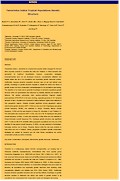| Journal Article |
 |
|
| Article Title | Tamarindus indica tropical populations genetic structure | | Author | P. Nyadoi, Ramni Jamndadass, P. Okori, J.B.L Okullo, J Obua, Magogo Nassoro, Haji Saleh, Pushpakumara DKN, James M Roshetko, Antoine Kalinganire, A. Muchugi, August B Temu, S. Fluch and K. Burg | | Year | 2010 | | Journal Title | Gene Conserve | | Institution | Gene Conserve | | Volume | 9 | | Issue | 37 | | Pages | 152-166 | | Call Number | JA0373-10 | | Keywords | Conservation, chloroplast, mitochondria, genetic resources, Tamarindus<\i> |
|
| Abstract: |
| Tamarindus indica L. (tamarind) is a tropical tree species widely managed for fruit and
other exported products in countries like India and Thailand. In Africa tamarind was
earmarked for livelihood diversification however, conservation strategies, products/markets were not yet developed moreover, unsustainable utilisation and
habitat losses has led to its populations and expectedly genetic resources erosion.
Additionally, because tamarind population structure was not yet well defined even
globally, knowledge on genetic structure requisite to classify the extent and nature of
genetic erosion and thus conservation needs/strategies for its populations was lacking.
The objective of our study was to generate knowledge on tamarind populations genetic
structure which we hypothesised was influenced by habitats, latitudes and isolation by
distance. We studied polymerase chain reaction–restriction fragment lengths polymorphisms (PCR-RFLP) in the slow evolving, organelle genomes of 311 tamarind
sampled on-farm, woodland and riverbanks in island-mainland, higher-lower latitudes of
nine geographic regions. Analysis revealed significant among geographic regions
mitochondria genetic structure (ST = 0.64) but only one of its 6 haplotypes was global
(overall frequency, 59.6%), one restricted to Kenya, Tanzania, Mexico (overall
frequency, 12.8%) and the rest endemic to Kenya (2), Indonesia (1) and Thailand (1).
The chloroplast was conserved (ST <= 0.02), only one of its 16 haplotypes was global
(overall frequency of 94%), 14 were rare endemics of East Africa and one restricted to
Kenya-Indonesia (overall frequency<1%). Cytotypes genetic structure was significant
(ST = 0.49) but with 51% variability within geographic populations and only one of the
identified 20 was global (overall frequency, 51.89%), one was restricted to Burkinafaso,
Indonesia, another one to Kenya, Tanzania, Mexico while the rest were endemic to
East Africa and one in Thailand. Clearly, geographic population specific conservation
strategies are needed for tamarind and the East African populations are worthy
conservation priority as centre of diversity. |
|
|
Download file(s): Click icon to download/open file.
|
|
|
|
GRP 1: Domestication, utilization andconservation ofsuperior agroforestry germplasm
|
| Viewed in 2538 times. Downloaded in 0 times. |
